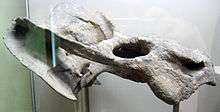Kannemeyeria
| Kannemeyeria Temporal range: Early Triassic | |
|---|---|
| | |
| Skull of Kannemeyeria erithrea | |
| Scientific classification | |
| Kingdom: | Animalia |
| Phylum: | Chordata |
| Clade: | Synapsida |
| Order: | Therapsida |
| Infraorder: | †Dicynodontia |
| Family: | †Kannemeyeriidae |
| Genus: | †Kannemeyeria Seeley, 1908 |
| Species | |
| |
| Synonyms | |
| |
Kannemeyeria was a large dicynodont of the family Kannemeyeriidae, one of the first representatives of the family, and hence one of the first large herbivores of the Triassic. It lived during the later Early and early Middle part of the Triassic period (from the late Olenekian to the Middle Anisian age).

Description


Kannemeyeria was about 3 m (10 ft) in length, about the size of an ox. It was well-adapted to living as a herbivore; it had a powerful beak and strong jaw muscles built for shearing plant material. Although it had a large head, it was lightweight due to the size of the eye sockets and nasal cavity. It also had limb girdles which formed massive plates of bone that helped support its heavily built body.[1]
Distribution
Kannemeyeria is known from Namibia, South Africa, and Zambia.